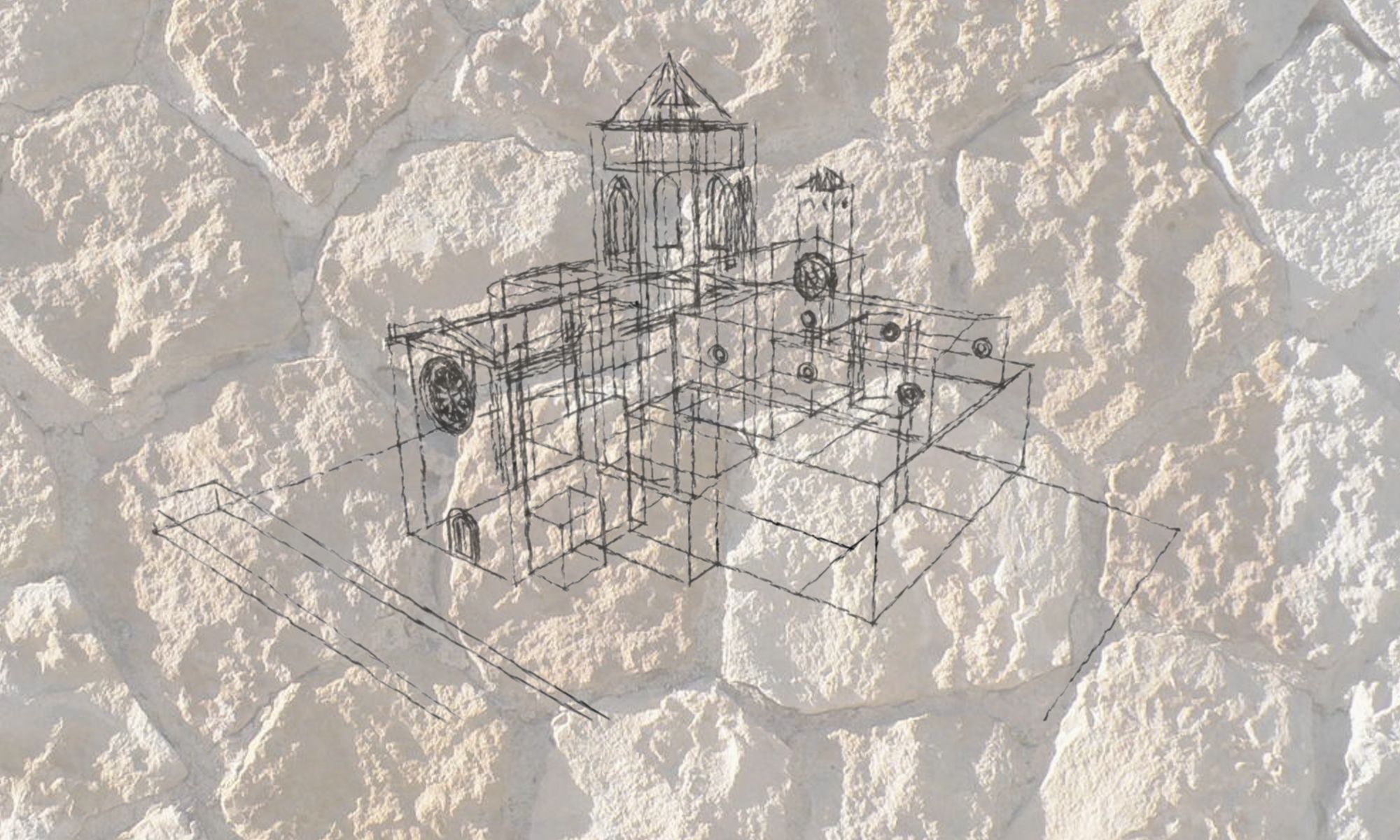Medieval church design – a glance into the past…. but how have ancient mason builders done their work ? How did they know about wall thickness and building height to last for centuries ? Todays monuments do not endure that by far….
Historic overview
Approx until year 500 AD (fall of west-roman empire) : The ancient roman basilica served as an example for early christian churches which were built after the “Edict of Milan” (Toleranzedikt von Mailand, it “declared that the empire would be neutral with regard to religious worship, officially removing all obstacles to the practice of Christianity and other religions”). In the ancient world a longish peristyle with side aisles was used for meeting– and jurisdiction purposes. This style was adopted for the first early christian churches with a heightened nave (see source [1a]). These first churches usually had a wooden ceiling and no vault but there were exceptions like the „Basilica of Maxentius“ in Rome (307-313 AD) source [1b]. The eastern side was usually equipped with a semi-circled apsis.


Approx 5. Century until 900 AD : Merovingian und carolingian period, in terms building history a form of pre-romance (e.g. the Pfalzkapelle in Aachen, Germany, today cathedral of Aachen). Therefore ancient structures were used as an example and then modified.
Approx. Year 900-1250 AD: Romance. Typically round arches and dark, fortress-style churches
Approx. Year 1140-1550 AD: Gothic, usually divided into early gothic, high gothic and late gothic period. In 1140 abbot Suger erected the abbey church St. Denis in France in gothic style. That revolutionary new style then spread across Central and Western Europe, from 1230 AD on also found in Germany (Elisabethkirche in Marburg, Liebfrauenkirche Trier)
A church built 700 years ago would be in the gothic period. The gothic style came from France and spread further and further across central and western Europe. Very typical for the gothic style is among others the pointed arches which solved a big problem of the romanesque builders : with round arches the spanned distance automatically defines the height of the arches; the gothic system offers far more possibilities for height and width of arches, windows and so on. The gothic style stands for height and airyness. The gothic concept tried to find a counterforce to all originating forces whenever possible at the place where the apply. Example : columns were seen as thin „bars“, instead of massive columns that could cope with forces from all directions. If shear forces apply (e.g. caused by the vault) they were eliminated by counter forces e.g. by buttresses outside.
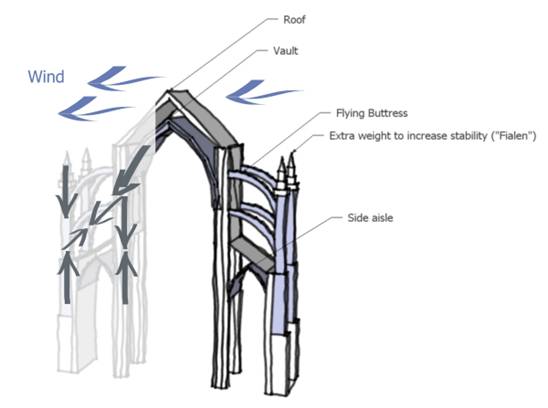

Approx. 1500-1650 A.D: Renaissance, influenced by ancient greek and roman styles with the focus on optimized, harmonic proportions.
Types of medieval churches
Basilica
The type „basilica“ was also used in the gothic period, usually with a high nave (“Hauptschiff”) and lower side aisles (“Seitenschiff” separated by columns). Often the nave has double the width of a side aisle. Mostly two but also four side aisles were used. The difference in the height between nave and side aisles made extra-windows above the aisles possible („Lichtgaden“)

Oriental basilika
The „oriental basilica“ is very similar to the basilica, but the difference in height between the nave and the aisles is smaller so that no extra-windows („Lichtgaden“)above the side aisles can be found. As a consequence this type of church is a mixture between „basilica“ and „hall church“ (see below).
Hall church
Here all naves / aisles have the same height for an enormous feeling of space. Hall churches can be found with wooden ceilings or vaults and were preferred from the 14th century on. [1c]

The nave and aisles can be spanned by one saddle roof or multiple roofs.
How were the churches constructed ?
The churches were usually aligned to the east with the choir. Therefore the designated place (mostly on a hill) was cleared and then the church outlined by using geometrical methods (e.g. a tower as an octagon) and simple calculations (+, -, /, *). The determination of the walls (height, width) must have based for centuries on verbally transmitted experience and NOT on static calculations as done today (that started not earlier than in the 18th century !). The experience was delivered e.g. in proportions like 1:10 width of wall to width of choir. There are almost no written (German) records from the time before the 15th century and those who exist are partly copies of originals that don’t exist anymore. There are some articles about the theory of architecture and basics about geometry.
According to source [4a] the following findings survived in the German / Austrian area
· Wiener Werkmeisterbuch (15. century, author unknown) · Von des Chores Maß und Gerechtigkeit (approx. 1500, author unknown)
· Unterweisungen (1516, Lorenz Lechler, court architect )
· Das Büchlein von der Fialen Gerechtigkeit (1486, Matthäus Roriczer, cathedral master-builder in Regensburg, Germany)
· Geometrica Deutsch (1487/1488, Matthäus Roriczer see above) [4b]
· Fialenbüchlein (approx. 1485, Hans Schmuttermayer)
as well as
· Bauhüttenbuch (1225 till 12356, Villard de Honnecourt, french master-builder or mason) [4c]
I used this source [2a] for the following article, worked it up on my understanding — if you find any errors please drop me a note.
Below some key proportions for the building are shown. Attention ! Source [2a] tested the significance of some key-rules on old churches in the southern German area and found quite a few matches. But it has to assumed that the presented proportions do not apply depending on building time, regional preferences and many more factors. Maybe you try on your own when you have the opportunity to visit an old church ? (please let me know)
choir
The width of choir is our main key factor. The use of an octagon (to be more specific : 5 sides of an octagon, the last three would point into the church) for the choir shape was very popular.
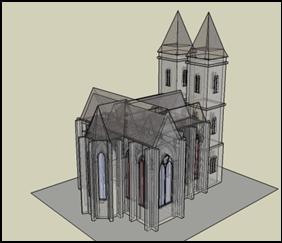
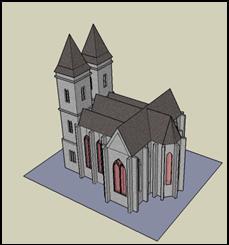
Above are two sketches of a church model that contains some of the medieval proportions. It includes a transept and two side aisles of same height as the nave so the church type „hall church“ is used. This model will be used further on.
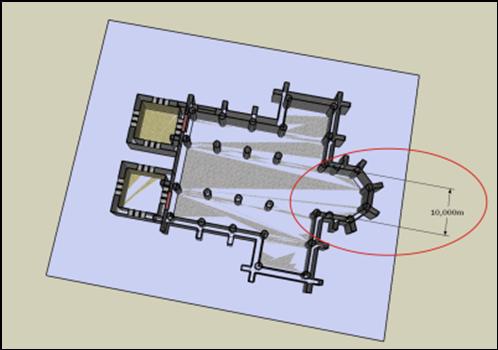
Wall thickness of choir
The wall thickness of the choir depends directly on ist clear width. The findings mentioned above usually used the proportion 1:10 (Choir walls to clear width of choir, see red arrows in sketch below). Depending on the quality of the available building materials the wall was made a bit thicker or thinner (a bit means the length of „a foot“ or a „shoe“ or whatever was used) .
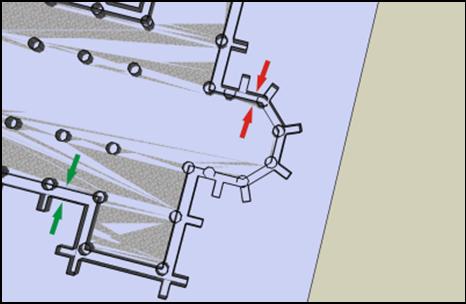
The wall thickness of the main house may alter from the wall thickness of the choir (see green arrows in sketch above and see „construction of main building“ below where factor „square root of 2“ was multiplied). It was seen as „optimum“ when the choir was 2x—3x as long as wide.
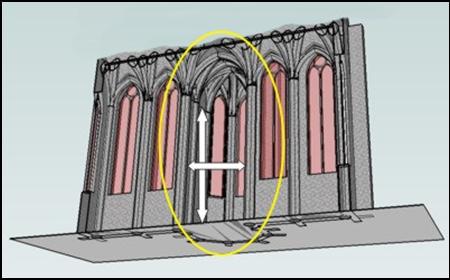
The height of the choir (until the spring of the arch) may be 1x—3x (optimum 2x) as high as its clear width. In this model it is 20m (2x10m of clear width of choir plus approx. 5m for the arch). The clear width of the choir equals (usually more or less accurate) the width of the main nave.
The construction of the main building with the length of the nave is not exactly specified, it highly depends on the size of community and the building site. A good value for the length of the main building was seen as double the clear width of the choir; the width of the main building (at least the nave) is same as the clear width of the choir. The height may be the same as the one of the choir, too, but may also alter between 1x—3x the clear width of the choir (until the spring of the arch). The thickness of the walls of the main house may equal the walls of the choir (1/10 clear width of choir) or be thicker with 1:square root 2 (SQRT) in relation to the wall thickness of the choir. The factor of square root 2 can be explained with the popular method of scaling by rotating squares 45° (see sketch below). Each „level“ the size is reduced by square root two and it was easily done with a pair of compasses („Zirkel“).

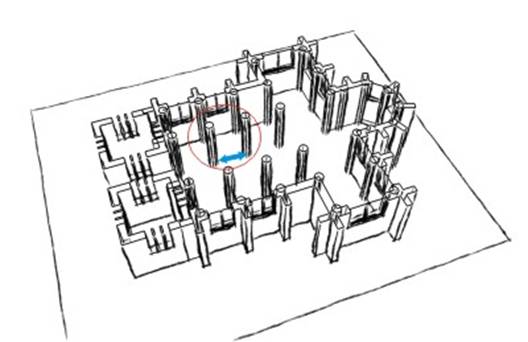
The distance of pillars is proposed with 1/2 to 2/3 of the clear width of the choir (from center to center) or 3x the wall thickness of the main building (clear width between the pillars, not from center to center). The pillars are proposed as octagons. The width of the pillars is proposed with 1+SQRT2 (=2,414):1 according to [2a].
Outside of the church are the buttresses that cope with the shear forces („Schubkräfte“) of the vault, see page 1 Gothic concept of eliminating forces with counterforces : the forces caused by vault do not only point vertically down (= weight) but also horizontally (shear forces) so that high walls could collapse if no counterforce is applied and that is the job of the buttresses. The buttresses also stabilize against wind forces that increase strongly with height. Buttresses may be a simple support directly on the wall with proposed width as width of choir walls, size (pointing away from church) 2:1 or SQRT2:1 to its width. Higher buildings may have a whole system of buttresses with arches, turrets and extra weight for stability (Fialen). Source [4c] reports on a dispute in the year 1400 between the builders of the cathedral of Milan (Mailänder Dom) and an called in foreign expert who specified the size for buttresses as 3x as the pillars inside. The report gives a good view on the understanding of statics of that time, so the builders of the dome of Milan must have stated that „all that is built mechanically well and perpendicular can never collapse no matter how high it is built“. The amount of shear forces caused by the vault (Gewölbeschub) must have been estimated very different at that time, it was not possible to calculate it.
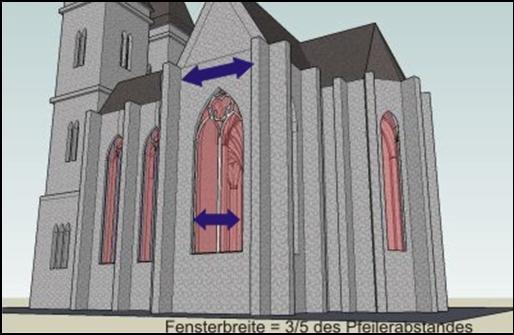
Looking at the vault for the construction of the crossed arch the source „Lechler“ (see findings above) has a rule : for wide widths to span the width of the walls is divided into 6 equal pieces so that the width of the crossed arch equals one of these 6 pieces, the depth of the crossed arch amounts 2 of the 6 pieces.
The roof is usually considered as an equilateral triangle.
contact
tproettel[at]yahoo.com (replace [at] by @)
Thomas Pröttel
Sulzweg 7
72631 Aichtal
Germany
